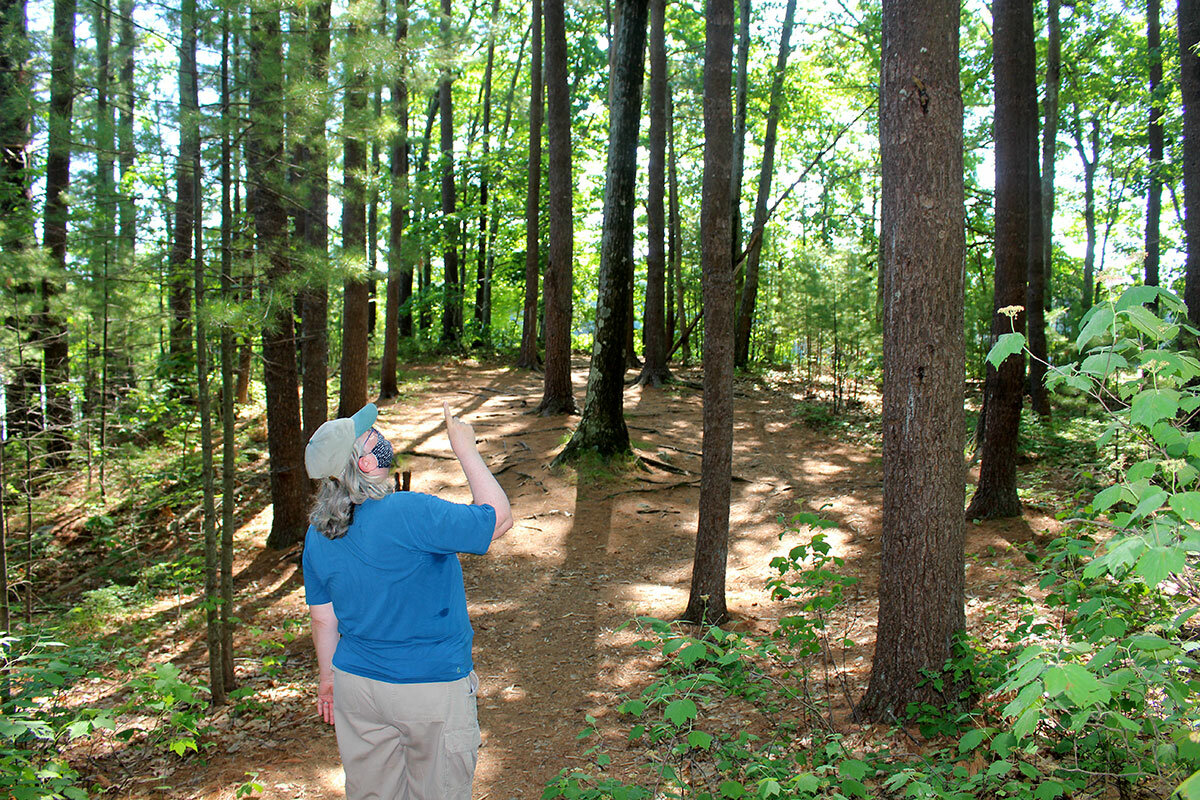Migratory birds in the crosswinds of federal, state protections
Loading...
| Stow, Mass.
A spotted sandpiper flies in spurts across Delaney Pond and alights on a bed of lilies near the water’s edge – right in the frame of Rita Gibes Grossman’s spotting scope.
“At 11 o’clock there are some yellow flowers, and then there’s that little lily pad island,” she says to Sandy Oxley, a fellow bird-watcher who had joined the small late-June expedition in the Delaney Wildlife Management Area.
Ms. Oxley raises her binoculars to the sandpiper, then skyward to the gliding form of a great heron. Humming nearby is a colony of ground-nesting bees.
Why We Wrote This
Federalism sometimes creates a seesaw effect between states and the federal government. When one side relaxes its rules, the other often rushes in to fill the gap.
The birds at this site have picked prime real estate for nesting season. The 580-acre swath of protected land sits in a state with a robust legacy of bird conservation. Migrating here across state lines, however, can be challenging for a bird – and it’s getting harder.
Migratory birds have been protected for a century under the 1918 Migratory Bird Treaty Act (MBTA), but a rollback of that federal law has turned conservation into a piecemeal network of state laws and regional efforts. To combat shrinking global bird numbers, states and towns are turning to collaborative conservation programs.
“Conservation works through strong partnerships and by working across boundaries,” says Katie Blake, conservationist at Highstead, a land conservation organization. “A wood thrush doesn’t stop at the border … and think ‘Oh wait, I should stop here because this is the state line.’”
Tough trek for birds
Nine out of 10 migratory birds are inadequately protected during at least one leg of their annual migrations, according to a 2015 study published in Science.
Before 2017, a person could be prosecuted for accidentally killing a bird, but an opinion submitted by the Department of the Interior effectively changed that interpretation so that only intentional harm – mainly illegal hunting – is legally punishable.
Critics say that, since that change, companies have been free to take fewer precautions to avoid migration paths or nesting grounds.
“Under the previous implementation of the MBTA, many states looked toward the federal government as the backstop, and leaned on the authorities … to both provide guidance and enforce that,” says Katie Umekubo, a lawyer representing the Natural Resources Defense Council and National Wildlife Federation in a lawsuit against the change to the MBTA.
“With that gone now, I think it’ll be a mixed bag. It’s yet to be seen how the states will react.”
Eight states including Massachusetts are challengers in the case. The Trump administration’s opinion has been in practice since 2017, but will likely become regulation after a public comment period ends on July 20.
With challenges like climate change and bird decline, “the work that is already ahead of a lot of conservation groups is so steep and constant that this would really exacerbate that,” says Ms. Blake.
A separate bill that would punish incidental killing of birds was introduced to Congress in January.
“Bringing birds back … is pretty darn complicated,” says Pamela Hunt, senior biologist in avian conservation at New Hampshire Audubon. She says the weakening of the MBTA isn’t “huge” for New Hampshire, where the law is often used to caution homeowners from disturbing nests near their houses.
Western states hosting big energy companies will see a stronger impact on their birds, she says.
The MBTA has been used to prosecute energy companies for failing to minimize the risk to birds of getting caught in wind turbines or electrical wires. BP had to pay $200 million to conservation efforts for violating the MBTA after its 2010 oil spill in the Gulf of Mexico.
Still, Dr. Hunt says bird protections need to go even further. “It involves Brazil and Trinidad and Guatemala and Florida. … Birds are going to be impacted somewhere else during the year when they’re migrating.”
The state of bird protections
July is nesting season, which means the spotted sandpiper back in Stow will be settled for a while in a state where bird-friendliness appears to be growing. In 2019, four acres of land were protected for every one developed in Massachusetts, up from a 2-to-1 ratio in 2005, according to Mass Audubon.
Massachusetts is “very, very strong in terms of lots of habitat, lots of protected land,” says Scott Edwards, professor of biology and curator of ornithology in the Museum of Comparative Zoology at Harvard University.
“Yeah, I would say Massachusetts is an excellent place to be a birder.”
Dr. Edwards is taking phone calls from the bike lane as he makes his own kind of migration across the United States. He’s biking to Oregon to raise awareness of Black Lives Matter and #BlackBirdersWeek, and to do some cross-country bird-watching.
Last week he pedaled through rural Indiana, where a “staggering” acreage of corn and soybean fields have taken over vibrant bird habitats. His route will later wind through the sprawling fields of the West – once dotted with greater sage grouse, but today a friendlier territory to oil and gas companies.
Dr. Edwards took off from Massachusetts, where the first Audubon society was founded in 1896 by Harriet Hemenway and Minna Hall, who were angered by the killing of millions of well-plumed birds for ladies’ hats. Their steadfast lobbying led in 1913 to an early version of the MBTA.
But even this state, home to naturalists past like Henry David Thoreau and present like David Sibley of “The Sibley Guide to Birds,” has seen changes.
“We have a river birch in front of our house, and during spring migration or even fall migration, it would be nothing to see more than a dozen yellow-rumped warblers” 20-odd years ago, says Ms. Gibes Grossman.
“Now, if I see two or three, it’s dramatic.”
The weakening of the MBTA is only the latest “chip away” at bird conservation, says Dr. Hunt. “I think keeping awareness of … what individuals can do is in some ways the most important thing.”
“If they care at least, that filters up.”
Shaded under Stow’s white pines, Ms. Gibes Grossman looks away from the spotted sandpiper to explain the relatively quiet morning. During migration season, “all the males have on their … courtship clothes, and they’re singing their little hearts out,” she says. “Now, they’re all nesting, they’re quieter.”
Ms. Oxley, a birder of 20 years, still delights in migration season. “It can be pretty intoxicating,” she says.








